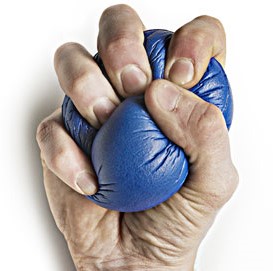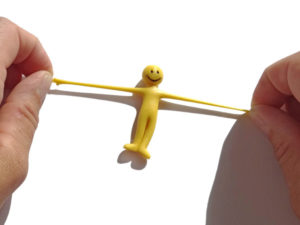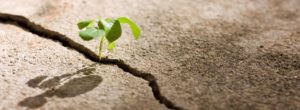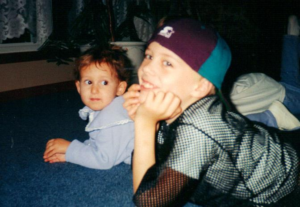
(The purpose of this 16-week blog is to shine the light on childhood cancer by sharing our family’s personal experience as I prepare to run my first ever half marathon and raise money to help children with cancer and their families. Be a part of the story! Donate here then share with your own family and friends.)
The subject of resiliency fascinates me.
An online dictionary defines resiliency as “being elastic, able to spring back into shape after being bent, stretched, or squashed.”
This reminds me of the stress ball that my boss handed out to all of us in the office last week. The idea is to squeeze the heck out of the ball and transfer all of your stress onto it. Not that any of us ever have stress at our workplaces! But just in case, the stress ball is resilient and can take it, right? It will spring right back into shape and your stress will be miraculously gone!
Have you ever felt like the stress ball? Squeezed, stretched, sometimes squashed? Bouncing back after a traumatic event is so very hard. It is often what we call “finding your new normal”. Having to find a “new normal” means that you can never get back to your old normal. Your life is forever changed because something significant happened.
But what makes one person resilient and the next person not so much, especially if they experienced a very similar traumatic event? Why is one more “elastic” than the other? Is resiliency something that can be learned?
LEARNING TO BE STRETCHY

I was recently asked to write the conclusion for a paper to be published through St. Jude Children’s Research Hospital describing what it has meant for me to be a part of the development of the bereavement program at St. Jude. Here is what I wrote…
“Eight months after my son Nick died of cancer, my sister Judy died suddenly. She had been living as a bereaved mom for 7 years after her son Mike died from complications of Cystic Fibrosis. Our family supported Judy in the best way that we knew how but, until I lost Nick, I couldn’t fully understand the depth of her grief. Judy was a single mom with 2 boys, one with CF and the other with Cerebral Palsy. Her life struggles set her up for complicated grief after Mike died and that is exactly what happened. When Judy was found dead in her home of an apparent heart attack, it was also discovered that over the past year of her life she had been living as a hoarder. Most of the time people become hoarders because they have experienced so much loss that they can no longer get rid of anything.
None of us knew.
In that moment, standing in Judy’s living room, I made a conscious decision that I would not end up the same way.
My sister is the reason why I became involved in the development of our bereavement program at St. Jude. I am determined to do whatever it takes to ensure that as few people as possible end up like Judy. If we are doing the best that we can to support our bereaved families, we are helping them to not only live, but eventually thrive again. Using bereaved parents as a part of that supportive process makes it even more meaningful as no one can understand what it feels like to lose a child except for another parent who has lost a child.
As our bereavement program grows and develops even further, I am hopeful that the things we have learned along the way might also be helpful to other institutions around the world as we strive together to bring hope and healing to bereaved families everywhere.”
Judy was my biggest source of support after Nick died because she knew exactly what it was like to lose a child. She was a fun and loving person who would give her last dollar to someone who needed it. She was never a super neat and tidy person but she was certainly never a hoarder. At first, I didn’t tell anyone about how we found Judy that day because I felt that it would embarrass my sister. But as time passed, I just knew that she would want me to talk about it and use her story to help others.
So why did grief and stress kill my sister and not me? I believe it’s because “in that moment, standing in Judy’s living room, I made a conscious decision that I would not end up the same way”. It was a choice that I made on that day, just 8 months after my own son died, that the grief of losing Nick would not also claim my life. I became determined to fight against the strong desire to give up. It is something that I still fight to this day and most likely always will.
POST TRAUMATIC…GROWTH?

A number of studies report that parents, especially mothers, who have experienced the death of a child, experience high rates of Post-Traumatic Stress Disorder (PTSD). Not a surprise.
In the first several years after Nick died, I had very vivid flashbacks about the horrific things that I had to watch happen to my sweet baby boy in the last few weeks of his life. They would come out of nowhere, usually when I was just starting to fall asleep. My heart would race and I suddenly couldn’t breathe (sort of like I was having an asthma attack). When I say that I fought a battle in my mind, I can assure you it was a very real fight. I knew that it would not change anything to relive the terrible things that had happened. It was only hurting me and would not bring Nick back. Over time, I found ways to stop the thoughts when they came and was determined to remember the first 15 years, 7 months, and 1 week of Nick’s life and not to dwell on the last 13 days.
It’s one thing to learn how to stop bad thoughts from taking over. It is a whole different thing to try and redeem the worst moments of your life by trying to plant a garden in your desert.
Recently, I read an article on Post-Traumatic Growth research that was done at the University of North Carolina at Charlotte…
“Post Traumatic Growth (PTG) is positive change experienced as a result of the struggle with a major life crisis or a traumatic event. The idea that human beings can be changed by their encounters with life challenges, sometimes in radically positive ways.
Posttraumatic growth tends to occur in five general areas. Sometimes people who must face major life crises develop a sense that new opportunities have emerged from the struggle, opening up possibilities that were not present before. A second area is a change in relationships with others. Some people experience closer relationships with some specific people, and they can also experience an increased sense of connection to others who suffer. A third area of possible change is an increased sense of one’s own strength – “if I lived through that, I can face anything”. A fourth aspect of posttraumatic growth experienced by some people is a greater appreciation for life in general. The fifth area involves the spiritual or religious domain. Some individuals experience a deepening of their spiritual lives; however, this deepening can also involve a significant change in one’s belief system.
Most of us, when we face very difficult losses or great suffering, will have a variety of highly distressing psychological reactions. Just because individuals experience growth does not mean that they will not suffer.” (https://ptgi.uncc.edu/what-is-ptg/ )
I will be watching the sun come up from above the clouds today as I make my way to Memphis, Tennessee. It is our annual Day of Remembrance at St. Jude Children’s Research Hospital. For the next several days, families from all over the world will also be making their way to St. Jude. They are coming because each has lost a child in the past 3 years. They are hurting. They are suffering. They each have a hole in their hearts and in their family that can only be filled by one particular child who is no longer here.
They are my sister.
They are me.
As I finish writing this blog in the darkness of the wee hours of the morning, I am in tears. I am overwhelmed with the desire I have for these families to return home after this weekend with the tiniest shred of hope, a crack of light in the darkness, a seed to plant in their desert.
I want them to know that they can live.
Even though song #13 on my Race Day Playlist is about a relationship breakup, it represents something very different to me. It is the song that Samantha S. and I sang out loud every week as it played from her phone and we gave ourselves manicures while chemotherapy dripped into her veins.
I babysat Samantha for many years from the time she was just a tiny baby. She became the 4th child in our family. Several years ago, Sam was also diagnosed with cancer and has survived.
 Nick and Samantha, 1999
Nick and Samantha, 1999
Enjoy Stronger by Kelly Clarkson. And know that when you donate to my race day, you are not donating to me but to Samantha and other survivors of childhood cancer…to keep them healthy and strong. Your donation will also help the families who will be spending the next few days at St. Jude remembering their child that is now gone, and so many more like them…to also keep them healthy and strong.
Be part of the story! Donate here…
If you are unable to donate financially, please consider passing along this message to others who can. Thank you!
http://fundraising.stjude.org/site/TR/Heroes/Heroes?px=2078389&pg=personal&fr_id=59186
Many of you who are reading this most likely know our Backstory, or at least part of it. If you don’t and would like to know more details of Nick’s story, you can visit his CaringBridge site here…